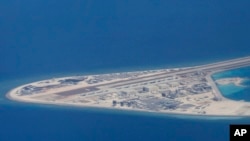China and members of the Association of Southeast Asian Nations, or ASEAN, are set to approve a framework for a code of conduct in the South China Sea.
ASEAN foreign ministers are expected to approve the document next week during a meeting in the Philippines. China’s foreign minister also will attend. The conference begins August 2 in Manila. The Philippines currently holds the chairmanship of ASEAN.
In 2002, China and ASEAN committed to begin work on a framework on nations’ behavior in the South China Sea. Previous negotiations over the years have failed to produce agreement.
But in May, China announced it had reached agreement with ASEAN on a framework. Officials have not provided many details about the document.
According to VOA’s Khmer Service, the framework is a non-binding code of conduct. That means it is not considered the basis for a law. It reportedly calls for closer cooperation to avoid disputes in the South China Sea.
An official from the area who did not want to be named provided VOA Khmer with a copy of the document. The goal of the document is to "establish a rules-based framework containing a set of norms" to guide the conduct of parties in the South China Sea.
China claims most of the South China Sea as part of its territory. Malaysia, the Philippines, Taiwan, Brunei and Vietnam also claim parts of the sea. This has led to disputes between China and some of its neighbors. In some areas, China has created artificial islands and built military bases.
The framework calls on ASEAN members to “promote mutual trust, cooperation and confidence, prevent incidents and manage incidents should they occur.”
It also urges creation of “a favorable environment for the peaceful settlement of the disputes; to ensure maritime security and safety and freedom of navigation and overflight.”
During a recent visit to the Philippines, Chinese Foreign Minister Wang Yi praised the framework code of conduct. He said it shows that China and ASEAN “have full capability and wisdom to solve disputes and safeguard the stability of the South China Sea.”
He added: "If there are still forces outside the region, who don't want to see stability in the South China Sea, and still want to stir up trouble in the South China Sea, we need to stand together and we need to say no to them together."
The framework document states that it is "not an instrument to settle territorial disputes or maritime delimitation issues." This language, along with the fact that the framework is non-binding, has led some experts to question its effectiveness.
Tang Siew Mun is head of the ASEAN Studies Center at the ISEAS-Yusof Ishak Institute in Singapore. He says the framework suggests ASEAN and China can work together on a "sensitive issue,” but it is just the first of many steps in the process.
"The COC would only have meaning if it were legally binding. But it is unsure if the negotiating parties would be agreeable to a fair and just structure of managing relations in the South China Sea," Tang said.
However, some experts suggest the agreement might ease tensions. Shihoko Goto is a northeast Asia expert at the Woodrow Wilson Center in Washington D.C. She told VOA Khmer the latest framework can be useful.
This is because it identifies possible sources of conflict and commits to finding common ground to avoid confrontations, Goto said. "That is progress, as worries about territorial claims continue," she added.
I’m Bryan Lynn.
Sok Khemara reported this story for VOA’s Khmer Service. Bryan Lynn adapted it for Learning English, with additional material coming from Reuters and Xinhua news services. Mario Ritter was the editor.
We want to hear from you. Write to us in the Comments section, and visit our Facebook page.
_____________________________________________________________
Words in This Story
framework – n. basic structure of something
code of conduct – n. set of laws or regulations governing behavior for a group or organization
non-binding – adj. having no legal force
confrontation – n. argument or clash over something
confidence – n. feeling or belief that something is true or will happen
maritime – adj. of or relating to the sea
wisdom – n. knowledge of what is proper or reasonable
stir – v. to cause something
delimitation – n. the marking of limits or boundaries












